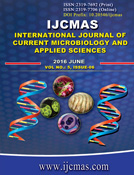


 National Academy of Agricultural Sciences (NAAS)
National Academy of Agricultural Sciences (NAAS)

|
PRINT ISSN : 2319-7692
Online ISSN : 2319-7706 Issues : 12 per year Publisher : Excellent Publishers Email : editorijcmas@gmail.com / submit@ijcmas.com Editor-in-chief: Dr.M.Prakash Index Copernicus ICV 2018: 95.39 NAAS RATING 2020: 5.38 |
Clindamycin is one of the important antibiotics for the therapy of skin and soft tissue infections caused by Staphylococcus aureus particularly MRSA (methicillin-resistant S. aureus). In vitro routine tests for clindamycin susceptibility may fail to detect inducible clindamycin resistance due to erm genes. Use of clindamycin in such cases would result in treatment failure. D-test (Disk approximation test) is an accurate and simple test which can be used for detection of clindamycin resistance in laboratory. The present study was carried out to determine incidence of inducible clindamycin resistance among clinical isolates of S. aureus by D-test. The study was conducted from April 2010 to May 2015. Total108 Staphylococcus aureus strains were isolated and identified from various clinical specimens. Antibiotic susceptibility testing including detection of methicillin resistance was done by disk diffusion method as per standard guidelines. All erythromycin resistant S. aureus isolates were subjected to D-test to detect the inducible clindamycin resistance as per CLSI guidelines. Out of total 108 S. aureus isolates, 50 were erythromycin resistant. Out of 50 erythromycin resistant isolates, 13 (12%) showed inducible clindamycin resistance, 4 (3.7%) showed constitutive resistance while remaining 33 (30.55%) showed MS phenotype in D-test. Inducible resistance was found to be higher in MRSA (23.8%). The incidence of inducible clindamycin resistance was 12% in present study. D-test is simple and handy test to detect inducible clindamycin resistance in S. aureus isolates. Clindamycin is not a suitable drug for D-test positive isolates while it can definitely prove to be a drug of choice in case of D-test negative isolates.
 |
 |
 |
 |
 |